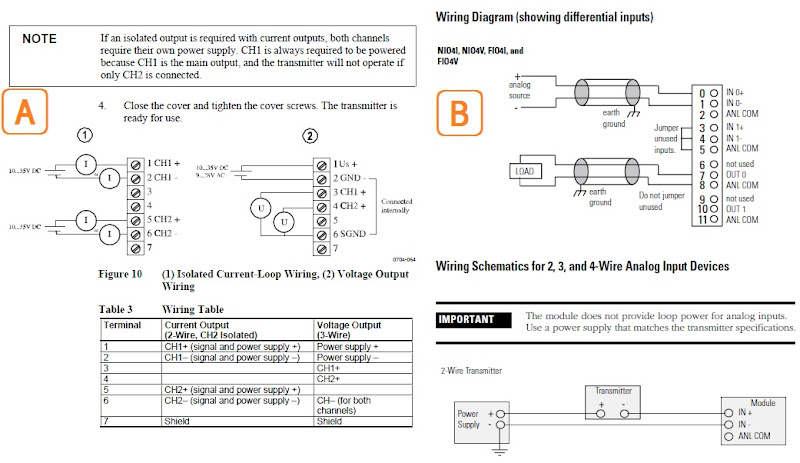Hi y'all!
I have a general question regarding wire selection in panels and also wiring sensors to PLCs.
I've seen plenty of I/O cards in PLCs wired with pretty thick wires, as shown in examples A and B in pic below. However, AB sells the IFM-ready cables with very thin wires, shown in examples C and D.

I've read that electrical engineers like the thicker cables because they are easier to manage and look a lot nicer than the thin ones. This seem to make sense, since the current is pretty low in these cards and does not require the thicker cables, is this a correct assumption?
Now, regarding cable selection to wire sensors to PLCs. The AB manual recommends using the "Belden cable #8761" for 2-wire sensor to analog I/O cards. Now, since I have a humidity/temperature vaisala sensor, it seems logical to me to be able to select another similar cable, but with 4 signal wires, is this a correct assumption?
So I'd like to stock a few rolls of wire that I can use for wiring my panels and sensors. Could you recommend the most common type of wire (and colors) for wiring 24v I/O discrete and analog cards to terminal blocks as well as wire for sensors? I'm looking for a way to stock a minimum amount of wire that can be use for multiple types of sensors and transmitters and for internal wiring between PLCs and terminal blocks and in some cases, 24vdc relays.
Thanks a lot in advance!
I have a general question regarding wire selection in panels and also wiring sensors to PLCs.
I've seen plenty of I/O cards in PLCs wired with pretty thick wires, as shown in examples A and B in pic below. However, AB sells the IFM-ready cables with very thin wires, shown in examples C and D.

I've read that electrical engineers like the thicker cables because they are easier to manage and look a lot nicer than the thin ones. This seem to make sense, since the current is pretty low in these cards and does not require the thicker cables, is this a correct assumption?
Now, regarding cable selection to wire sensors to PLCs. The AB manual recommends using the "Belden cable #8761" for 2-wire sensor to analog I/O cards. Now, since I have a humidity/temperature vaisala sensor, it seems logical to me to be able to select another similar cable, but with 4 signal wires, is this a correct assumption?
So I'd like to stock a few rolls of wire that I can use for wiring my panels and sensors. Could you recommend the most common type of wire (and colors) for wiring 24v I/O discrete and analog cards to terminal blocks as well as wire for sensors? I'm looking for a way to stock a minimum amount of wire that can be use for multiple types of sensors and transmitters and for internal wiring between PLCs and terminal blocks and in some cases, 24vdc relays.
Thanks a lot in advance!




